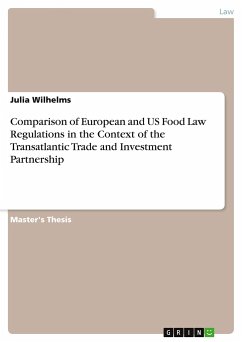
Comparison of European and US Food Law Regulations in the Context of the Transatlantic Trade and Investment Partnership

PAYBACK Punkte
0 °P sammeln!
Master's Thesis from the year 2014 in the subject Law - Comparative Legal Systems, Comparative Law, grade: 1,3, University of Bonn, course: Lebensmittelrecht, language: English, abstract: In July 2013, negotiations concerning the Transatlantic Trade and Investment Partnership (TTIP) were initiated. Objective of the negotiations is the generation of a Free Trade Agreement (FTA) between the United States (U.S.) and the European Union (EU) to promote trade by reducing trade barriers, including tariff and non-tariff ones. In order to achieve this goal, several issue barriers have to be addressed, ...
Master's Thesis from the year 2014 in the subject Law - Comparative Legal Systems, Comparative Law, grade: 1,3, University of Bonn, course: Lebensmittelrecht, language: English, abstract: In July 2013, negotiations concerning the Transatlantic Trade and Investment Partnership (TTIP) were initiated. Objective of the negotiations is the generation of a Free Trade Agreement (FTA) between the United States (U.S.) and the European Union (EU) to promote trade by reducing trade barriers, including tariff and non-tariff ones. In order to achieve this goal, several issue barriers have to be addressed, inter alia concerning non-tariff barriers including regulatory differences in the sectors of agriculture and food production. While the U.S. and the EU both have high standards concerning the consumer protection and food safety assessment, differences in the basic principle and implementation persist. Both countries pursue an agreement that follows the respective principles and still provides effective trade stimulation. However, based on the rooted differences in the particular food safety systems, challenges are inevitable. The objective of this study is the presentation of the U.S. and EU food safety system as well as special cases highlighting the differences between both systems in terms of risk assessment, prevention, responses and risk communication. The different factors are analyzed both theoretically and on the basis of practical examples. Additionally, the different matters are described in the context of the TTIP to identify issues that may complicate the negotiations. Possibilities to resolve those issues are discussed and recommendations for positive outcomes given.













